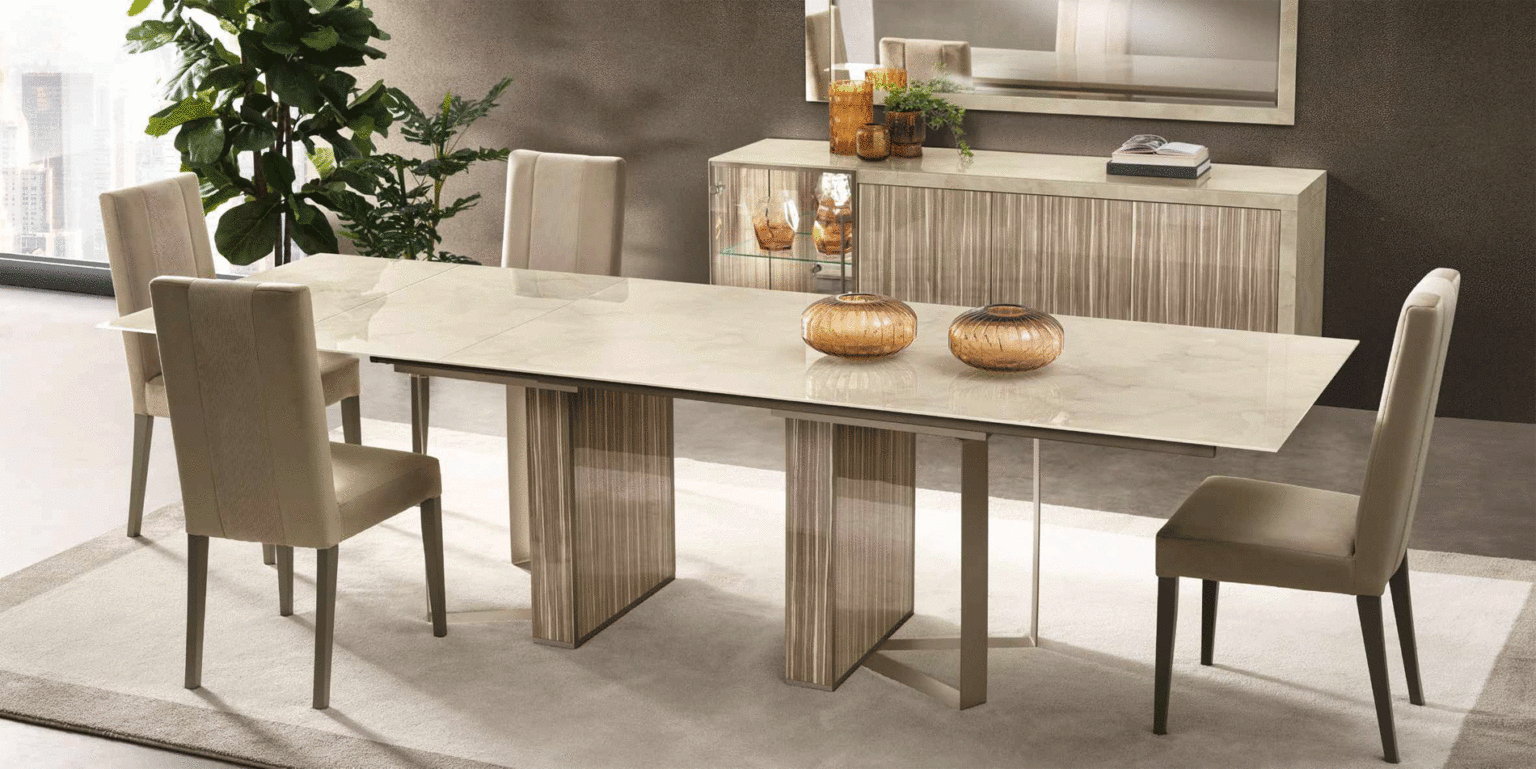How Tall are Dining Tables – Standard Dining Room Table Height

When choosing a dining table, height is a crucial consideration. Whether you’re furnishing a new dining room or replacing an old piece, understanding the ideal dining table height will ensure comfort, functionality, and style. This guide explores standard dining table heights, factors affecting height choices, and the various types of dining tables available to suit your needs.
Choosing the right dining table height is key to both functionality and style. While the standard dining table height is ideal for formal settings or when expanding with leaves, alternative heights offer greater versatility. At Mobilia Cleopatra, we offer a variety of options, including counter-height and bar-height tables. These alternatives can enhance the ambiance of your space, making it feel open and sophisticated. Understanding the differences between these options ensures you select the dining table height that suits your home’s style, needs, and preferences.
How Tall Are Dining Tables?
When furnishing a dining room or kitchen, one of the key factors to consider is the height of the dining table. The height can significantly affect the comfort and functionality of the space, influencing everything from the seating arrangement to the overall aesthetic of the room. So, how tall are dining tables? Let’s dive into the typical height ranges, variations, and what to consider when selecting the right dining table for your space.
Standard Dining Table Height
The standard height for a traditional dining table is between 28 and 30 inches (71 to 76 cm). This range has become the go-to measurement for most dining tables, offering a comfortable balance between ergonomics and style.
- Why This Height Works: The 28-30 inch range is designed to accommodate the average dining chair, providing enough space for legs to comfortably fit under the table while ensuring that diners can sit upright. Most dining chairs have a seat height of about 17 to 19 inches (43 to 48 cm) from the ground, creating a natural and ergonomic dining experience.
- Comfort Considerations: For most people, this height range allows for comfortable eating posture—arms bent at a natural 90-degree angle while eating, with feet resting flat on the floor. If you’re purchasing a dining table or chairs separately, it’s important to ensure the seat height and table height are compatible for maximum comfort.

How Tall are Dining Tables
Variations in Dining Table Height
While 28 to 30 inches is considered standard, dining tables come in several other heights to suit different spaces, aesthetics, and functions.
1. Counter-Height Dining Tables
Counter-height tables are taller than the standard dining table, typically ranging from 34 to 36 inches (86 to 91 cm). These tables are becoming increasingly popular in kitchens or open-plan spaces, where they often double as a dining table and a prep or work surface.
- Best for Small or Casual Spaces: Counter-height tables are perfect for a more casual, modern dining experience, often paired with stools rather than traditional chairs. They also work well in smaller kitchens or dining areas, providing a more relaxed, intimate setting.
- Height Considerations: The seats for counter-height tables are generally between 24 to 26 inches (61 to 66 cm) high, and the stools are typically more comfortable than standard dining chairs when paired with the extra height.
2. Bar-Height Dining Tables
Bar-height tables are the tallest option, generally measuring between 40 and 42 inches (102 to 107 cm). These tables are often used in bars, pubs, or high-top dining areas, giving a trendy, elevated feel to the space.
- Ideal for Entertaining: Bar-height tables are often used for informal gatherings, drinks, and casual dining. They are typically paired with bar stools, which have a seat height of about 28 to 30 inches (71 to 76 cm).
- Not Ideal for Formal Meals: Due to their height, bar-height tables may not be the most comfortable for long, formal meals, but they can work well in more laid-back settings where the focus is on conversation and social interaction.
How to Choose the Right Dining Table Height
Choosing the right height depends on several factors, including the size of the room, the type of seating, and how you plan to use the space. Here are some tips to help you decide:
- Consider the Room Size: In smaller rooms, counter-height or bar-height tables may make the space feel more open and airy. In larger rooms, a standard dining table can create a sense of balance and proportion.
- Type of Seating: Think about what kind of chairs or stools you’ll be using. If you prefer traditional chairs, a standard height table is ideal. For barstools or stools, counter or bar-height tables will work best.
- Function of the Space: If you’re creating a formal dining area, a standard-height table is likely the most appropriate. For informal meals or areas that serve multiple functions, such as a kitchen or entertainment area, you might prefer a counter or bar-height table.
FAQs
Below are some common FAQs about how tall are dining tables
1. What is the height of a standard dining table?
A standard dining table typically ranges from 28 to 30 inches (71 to 76 cm) in height. This height is ideal for comfortable dining and works well with most dining chairs, which usually have a seat height between 17 and 19 inches (43 to 48 cm).
2. What is the difference between standard height, counter height, and bar height dining tables?
The main difference between these types of dining tables is their height:
- Standard height tables are 28 to 30 inches (71 to 76 cm) tall and are the most common type of dining table.
- Counter-height tables are slightly taller, typically between 34 to 36 inches (86 to 91 cm), and are commonly used with stools. These are often found in kitchen dining areas or open-plan spaces.
- Bar-height tables are the tallest, ranging from 40 to 42 inches (102 to 107 cm). They are typically used in more casual settings and are paired with tall bar stools.
3. What dining table height is best for small spaces?
For small spaces, counter-height tables (34 to 36 inches) are often the best option. Their height creates a more compact and less bulky appearance, making the room feel more open. Counter-height tables can also work well with space-saving stools that can be tucked underneath when not in use.
If you’re working with a particularly tight space, round tables (regardless of height) can also help maximize seating while reducing the visual clutter of sharp corners.
4. How tall should a dining table be for comfort?
A dining table should be 28 to 30 inches (71 to 76 cm) tall for the most comfortable dining experience for the average person. This allows diners to sit at the table with their feet flat on the floor and their arms at a relaxed 90-degree angle, which is ideal for eating and interacting during meals.
When selecting a table, ensure that the seat height of your chairs is between 17 and 19 inches (43 to 48 cm) to match the table height and maintain ergonomic comfort.
5. Can dining table height affect posture and comfort?
Yes, the height of your dining table can directly impact your posture and comfort. A table that is too high or too low can cause strain on your back, neck, and wrists. If the table is too high, you might find yourself reaching up, causing tension in your shoulders. On the other hand, if the table is too low, you might feel like you’re slouching or bending forward to reach your food.
Choosing the right height table helps maintain a neutral sitting posture, allowing you to eat comfortably for longer periods. That’s why 28 to 30 inches is the most widely accepted height, as it suits most people.
6. Are adjustable-height dining tables available?
Yes, adjustable-height dining tables are available on the market. These tables are particularly useful in spaces where flexibility is important. With an adjustable dining table, you can raise or lower the height based on your needs, transitioning between standard, counter, or bar height settings. These tables are ideal for homes where the dining area serves multiple purposes or for those who prefer versatility.
While adjustable dining tables are less common than fixed-height models, they are gaining popularity in modern homes and multipurpose spaces.
7. Are there any dining tables suitable for people with disabilities or special needs?
Yes, there are customized dining tables designed to accommodate specific needs, including tables with adjustable heights or those designed with extra clearance for wheelchair access. For example, tables with a height range from 28 to 34 inches can be adjusted to accommodate someone in a wheelchair or with limited mobility.
If you or someone in your household requires special accommodations, many manufacturers offer height-adjustable tables that are designed for ADA compliance (Americans with Disabilities Act), providing additional comfort and accessibility.
8. What dining table height is best for entertaining?
For casual gatherings and entertaining, a counter-height table or bar-height table is often preferred. These tables create a more relaxed, social atmosphere where guests can stand, mingle, or sit comfortably while eating or drinking.
- Counter-height tables (34 to 36 inches) work well in kitchen islands or informal dining areas.
- Bar-height tables (40 to 42 inches) are great for cocktail parties or gatherings where people might prefer to stand or use high stools.
Both height options encourage conversation and interaction, making them ideal for casual entertaining.
9. How do I measure the height of a dining table?
To measure the height of a dining table, simply measure from the floor to the underside of the tabletop. Use a tape measure or ruler, and make sure to measure at the center of the table for the most accurate result. The typical height range for standard tables is 28 to 30 inches (71 to 76 cm), but if you have a specific type of seating in mind (like counter stools or bar stools), adjust accordingly.
Conclusion
In most cases, dining tables range from 28 to 30 inches in height, providing a comfortable dining experience for most people. However, variations such as counter-height (34-36 inches) and bar-height (40-42 inches) tables offer flexibility for different spaces and needs. When selecting the right table, consider the seating style, the size of your space, and the type of dining experience you want to create. By understanding the different height options available, you can make an informed decision that maximizes both comfort and style in your dining area.

